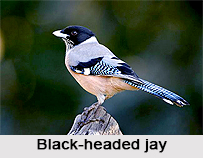 Black-Headed Jay or Lanceolated Jay is an Indian bird that bears a scientific name "Garrulus lanceolatus" that stays in the dense forest, jungles and the villages in the Indian states and the other Asian countries.
Black-Headed Jay or Lanceolated Jay is an Indian bird that bears a scientific name "Garrulus lanceolatus" that stays in the dense forest, jungles and the villages in the Indian states and the other Asian countries.
Population of Black-Headed Jay
The population of Black-Headed Jay trend appears to be stable, and hence the species does not approach the thresholds for Vulnerable under the population trend criterion. The population of Black-headed jay is suspected to be stable in the absence of evidence for any declines or substantial threats.
Structure of Black-Headed Jay
Black-Headed Jay or Lanceolated Jay is roughly the same size as its close relative the Eurasian Jay, but a little more slender overall except for the bill which is slightly shorter and thicker. The top of the head is black and it has a more obvious crest too and a longer tail.
Concentration of Black-Headed Jay
Black-Headed Jay or Lanceolated Jay ranges from eastern Afghanistan eastwards, across the Himalayas, from India to Nepal and Bhutan. It occurs in wooded country with large areas of open ground rather than dense forest. It also occurs in some cultivated areas and even near villages as long as there are enough trees and scrubland nearby. Black-Headed Jay is found in dense population in Palampur in Kangra Valley, Himachal Pradesh.
Feeding of Black-Headed Jay
Black-Headed Jay or Lanceolated Jay feeds both on the ground and in trees, and takes virtually the same wide range of plant and animal foods as its close relative, including eggs and nestlings, as well as scraps near human habitation.
Nests of Black-Headed Jay
Black-Headed Jay or Lanceolated Jay nests in trees and suitable bushes and this resembles the Eurasian jay in every respect.
Eggs of Black-Headed Jay
There are usually 3-5 eggs incubated over 16 days. Both parents feed the young.
Call of Black-Headed Jay
The voice of Black-Headed Jay or Lanceolated Jay is very similar to its close relative too and is most often a loud screech but with longer pauses in between.



















